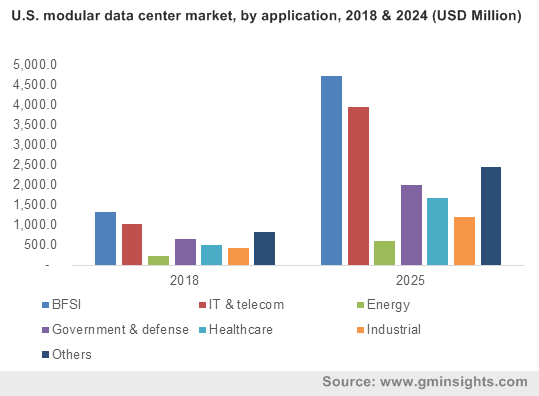North America modular data center market to emerge as one of the most lucrative terrains, global industry valuation to hit USD 50 billion by 2025
Publisher : Fractovia | Published Date : 2019-04-30Request Sample
The global modular data center market is witnessing an unprecedented momentum in the past few years owing to an explosion in demand for IT services that has put mounting pressure on traditional data centers. The data centers of the 21st century are transforming themselves from being just massive outsourced installations or on-premise facilities running enterprise applications into something which is more in sync with the requirements of this time and age. Undoubtedly, modular data centers have emerged as effective options to power disruptive technologies such as the Internet of Things, cloud computing, and big data.
U.S. modular data center market, by application, 2018 & 2024 (USD Million)

While elaborating further upon the modular data center industry expansion trends, it is quite prudent to take note of the fact that the business needs for designing a data center have remained fairly consistent around capital cost, capacity, and availability of expertise. However, the fulfilment of these three requirements no longer ensures augmentation of the new technological tools and computing models that are transforming the way traditional data centers function. These factors are predominantly leading to the large-scale installation of modular data centers across various end-use sectors such as energy, healthcare, BFSI, and telecom.
Implementers of the modular data centers at the highest level often experience latency reduction from hundreds of milliseconds to less than 10 milliseconds, apart from bandwidth savings which make sure ROI for associated line items is quicker. In this context, it would be prudent to take note of the rising influence of modular data center industry in the research domain across the world.
For instance, the new high-performance computing implementation currently progressing at Large Hadron Collider “beauty” project of European Organization for Nuclear Research (CERN) would be backed by a prefabricated 3 MW data center facility. Remarkably, this modular data center architecture (consisting of six modules) would ensure rapid rollout in a few months, cost optimization, and eliminate the need for specialized support skillsets.
North America – the fast-emerging terrain for modular data center market expansion
In terms of geographical expanse of modular data center industry, the North American region is one of the most promising growth terrain owing to its advanced IT infrastructure and stable economic conditions. Apparently, the exponential rise in the usage of connected devices and high rate of internet penetration has led to increase in the demand for modular data centers in the region. According to trusted sources, the North America modular data center market is set to register an annual growth rate of 20 percent over 2019-2025.
Specifically, the U.S. has been one of the foremost nations in this region to have witnessed the wide-scale installation of module data centers for defense and military applications in the recent past. Enumerated below are a few prominent instances which underscore the U.S. military’s increased inclination toward installing modular data centers at its foreign bases:
- It has been reported that the U.S. Army Contracting Command is working at a brisk pace to deploy modular data centers in Iraq. These facilities would help the U.S. Army while operating in harsh austere environments that will need to be available on a 24/7 basis and provide operational communication services. These communication services would be crucial in attaining the laid out by U.S. Army in Iraq MOD missions and operations.
- In February this year, the U.S. Air Force announced that it intends to install a scalable modular data center at the Lakenheath base of the British Royal Air Force. The base hosts units and personnel of U.S. Air Force and is known as the home to the 48th Fighter Wing, also called as the Liberty Wing.
Existing enterprise computing strategies of almost all multinational companies are set to be rewritten as the technology trends are being increasingly characterized by an exponential growth in data traffic. As the next generation business models call for the creation of large-scale computing infrastructure in less time, the demand for modular data centers would witness unprecedented increase in the times to come.
Moreover, the rising awareness pertaining to the deployment of green data centers which support green initiatives along with power regulations laid out by government would aid the growth of modular data center market. In fact, as per a research report put together by Global Market Insights, Inc., the commercialization scale of modular data center industry is slated to surpass an overwhelming figure of USD 50 billion by 2025.